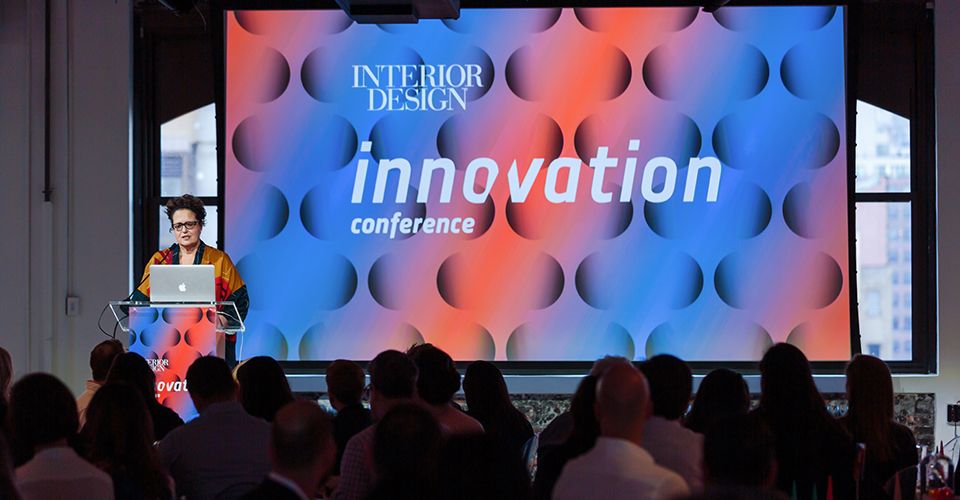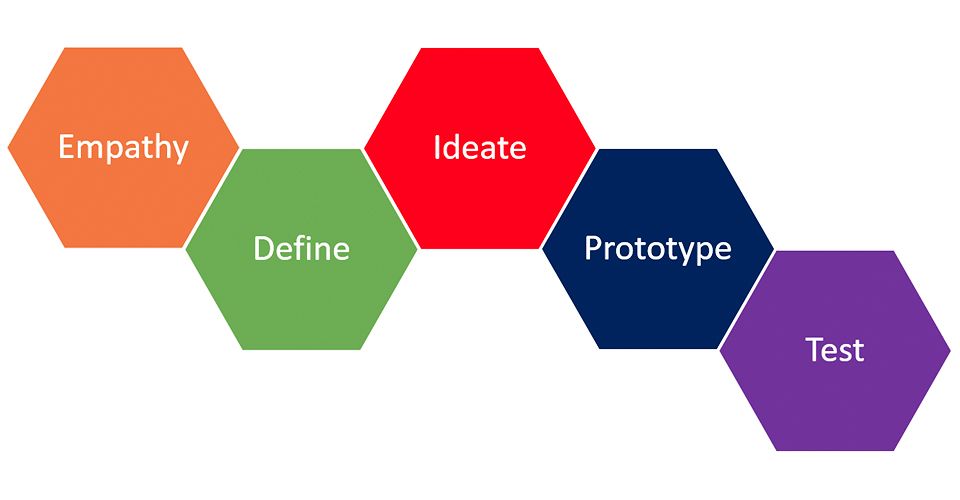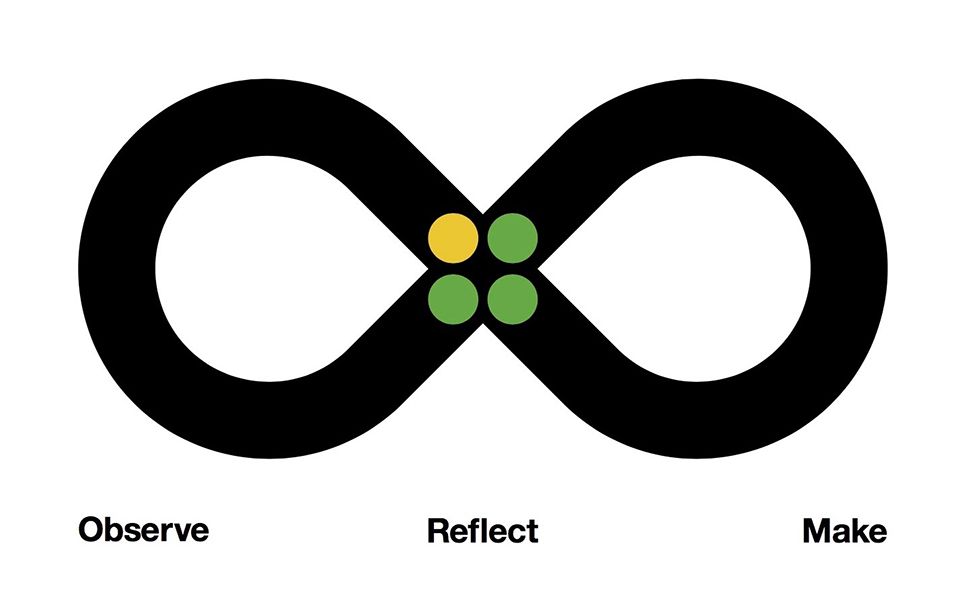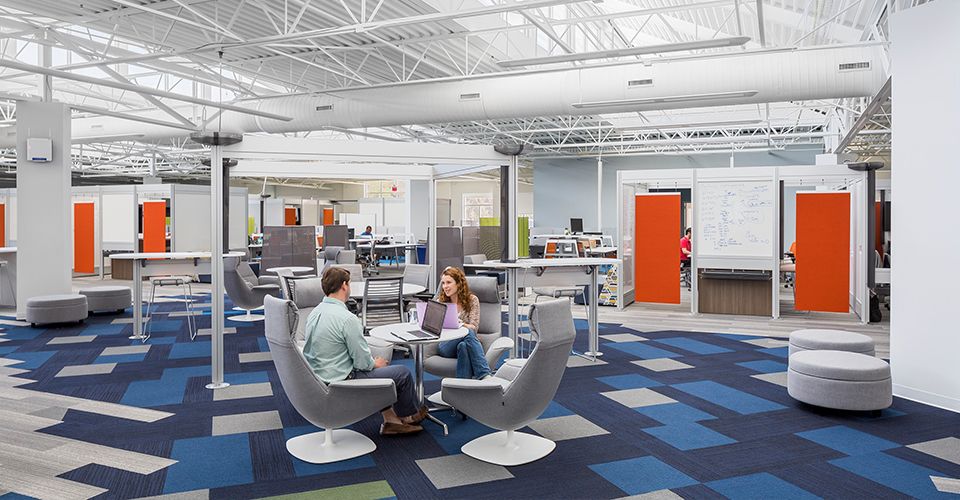What does innovation mean? What does it mean to be innovative?
At the inaugural Innovation Conference hosted by Interior Design and Interface, speakers and panelists gave their perspectives on what innovation looks like when it comes to retail, organizations, and sustainability. (For a summary of the entire day, check out Interior Design’s full coverage of the event.)

Interior Design Editor in Chief Cindy Allen kicks off the Innovation Conference. Photography by Erik Bardin
One of the biggest takeaways from the day? Innovation happens when you build physical and psychological space that allows you to think creatively.
Disrupting the design thinking model
Design thinking is a popular framework for problem solving and innovation. The five-phase process allows designers to tackle problems in a methodical way.

The typical design thinking model.
Companies like IBM have taken design thinking one step further. As a legacy company that’s been around for over century, it’s had to adapt and innovate at scale. One of the tactics that’s allowed IBM to do this has been what it calls IBM Design Thinking or “enterprise thinking.” By embedding designers within cross-functional teams, it makes design thinking the universal approach to work for its teams across the world.
“[IBM] used to change what we worked on; now we’re changing how we work…The ways we solve problems have to adapt, just as the problems themselves adapt.” – Seth Johnson, IBM Design Program Director
Enterprise design thinking simplifies the normal design thinking process into a loop of observe, make, reflect.

The IBM Design Thinking loop. Image © IBM.
Rather than the linear framework of standard design thinking, IBM’s model allows teams to start wherever they need to in the process, making them more efficient — and ultimately more innovative.
What does that look like within organizations?
How did IBM get to where they are today? It created a culture that fosters creativity and encourages cognitive diversity.
How can other organizations copy this approach? Focus on trust and collaboration in the workplace. According to executive coach and Innovators + Influencers founder Michael O. Cooper, clear ways companies can do this are to:
- Create psychological safety.
- Create cognitively diverse teams.
- Foster a high-trust culture.
- Give people autonomy. Promote curiosity and experimentation. Support failure (within reason).
- Recognize quality work and effort frequently.
- Spend time and effort to build alignment. You can’t get aligned by email.
- Nurture cooperation. Give people the info they need to do their job.
- Reduce or eliminate bureaucracy.
- Provide sufficient resources and time.
- Offer support, guidance and feedback frequently.
- Makes space and time for divergent and convergent thinking.
- Find interesting work or make the work more interesting.
The point is: external innovation has to be driven by internal creativity. For companies to keep up, they have to give their employees the permission to be creative and the psychological space to create meaning in the work they do.
Keeping the next generation in mind
It would be a mistake not to point out the relationship between the twelve actions above to the growing influence of millennials in the workplace. Millennial workers have demanded more of their employers than any generation before them — to the benefit of all. In multi-generational teams and companies, innovation takes on a new social responsibility. No longer a means to a purely capital end, innovation reinforces personal (or organizational) integrity and purpose.
“The next generation of innovators is the next creative class.” – Becky Wang, CEO and Co-Founder, Crossbeat
The generation that values independence, well-being, constant improvement, and mutually beneficial interaction is not only influencing social conversation but also workplace design.
Creating physical space for innovation to happen
Never underestimate how physical space affects those who inhabit it. And as a designer or architect, never underestimate the responsibility you have to create physical spaces that allow creativity and innovation to flourish.
There’s a reason that workers hate open office design: it’s noisy and there’s no privacy. In fact, research shows that there’s actually less face-to-face collaboration in open-plan offices. Since environmental stress is a key factor in worker well-being and productivity, designers have to anticipate that during the planning phase of a project.

Physical space is just as important when it comes to employee creativity. And it’s up to designers and architects to advocate for +Positive spaces in projects big and small. Architect/Interiors: McMillan Smith Pazdan, Photo: Firewater Photography
As office space evolves to fit workforce needs, designers are seeing a premium placed on comfort. The rise of biophilic design research and the WELL Building Standard bear this out, balancing against the increasing technological needs of the modern workspace.
Innovation is hard to define. It’s a word we understand intrinsically but can’t always explain. We also know that it doesn’t happen in a vacuum — innovation goes hand-in-hand with creativity. And it’s the equal responsibility of companies and designers to remove physical and psychological friction. For companies, it involves looking at culture to improve employees’ ability to create. For designers, it’s all about making spaces that nurture and inspire.
One response to “How to Foster Creativity and Innovation in the Workplace”
Absolutely agreed! Give your employees the much needed creative outlet at work and see them excel beyond expectations! Here are our 6 full proof ways to do that! https://www.peoplehum.com/blog/6-ways-to-foster-employee-creativity-and-motivation/